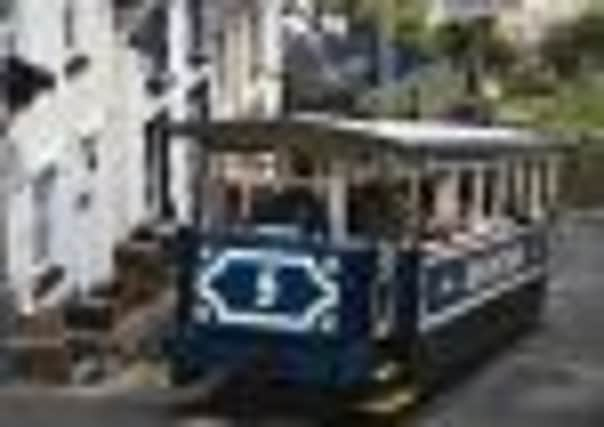Land of my fathers


Approaching Conwy its impossible not to be captivated by the views. First, across the estuary there’s the Great Orme headland and Thomas Telford’s suspension bridge, then as you get closer Edward I’s mighty fortress of Conwy Castle, with its eight huge round towers.
We pass through the narrow gate in the town walls, which were built to keep Welsh people like me out. Seven hundred years ago I would have been pelted with missiles from the three turrets of the Barbican above. That’s all in the past. Today in Conwy even the parking wardens smile.
Advertisement
Hide AdAdvertisement
Hide AdTo get your bearings it’s worth walking the walls. It’s less than a mile round and offers views of the mountains of Snowdonia and across to Llandudno and the chance to look down into backyards and smell the aroma from Conwy’s many cafes and restaurants which drifts up.
It’s all very tempting, especially the thought of some of Conwy’s famous mussels, but there’s no time. We’re about to go back 4,000 years to the Bronze Age. Our destination? The Great Orme Ancient Mines; the largest Prehistoric mine so far discovered in the world. Inside the labyrinth we squeeze our way through narrow passages where our forefathers searched for copper ore, using nothing more than stones and tools made from animal bones. Far beneath us are nine other levels, some with tunnels so small that only children as young as five could possibly have worked them. The wow factor is provided by a huge chamber, said to be the largest underground excavation in the world.
An even bigger wow comes a little later. This time it’s the sunset, as seen from the summit of the Great Orme above Llandudno. We watch the last rays slipping down over Anglesey and the Menai Strait as Conwy lurks in the shadows. We’re inspired to explore the Orme on foot next day, hoping to spot some of its Kashmiri goats. The headland’s buzzing with wildlife, though these wild goats elude us. Perhaps they know something that we don’t. The locals say that the animals are great weather forecasters and make their way to the lower slopes when rain is on its way.
The Great Orme rises from the Irish Sea like a giant monster above Llandudno. The steepest path up it is the Zig Zag Trail, accessible from the West Shore. This is by far the quieter face of the resort. The North Shore has open-top bus rides, land trains and Punch and Judy shows. And that’s not to mention the pier – Wales’s longest at 2,200ft – with its amusements, seaside stalls and refreshment kiosks. On the Zig Zag it’s only a mile to the summit and the views across the estuary to Snowdonia are every bit as stunning as we anticipated.
Advertisement
Hide AdAdvertisement
Hide AdOn the journey back down to Llandudno we ride one of the restored Victorian tram cars on the UK’s only cable-hauled tramway. Even more fun is the cable car back to the top. The 10 minute ride glides above the pleasure gardens of Happy Valley, with their splashes of colour.
We don our walking boots again to tackle a very small part of the Offa’s Dyke path. The 180-mile route to Chepstow in South Wales starts on the seafront at Prestatyn and winds up through the Clwydian Mountains.
From above the tiny village of Rhuallt, Rhuddlan Castle is just visible besides the Clwyd river. This is the second of Edward I’s great “iron ring” of castles in North Wales, although it’s nothing like as well preserved as Conwy. Down the years the locals have helped themselves to the stones from the four-storey towers and twin-turreted gatehouse, but with its huge round towers and deep moat, it’s nevertheless impressive.
One great way of exploring the area is the North Wales Coastal Cycle Path, which you can join at various points close to the sea. East of Prestatyn, we pick it up near Talacre, dismounting to wander through the dunes of the nature reserve to the beach.
Advertisement
Hide AdAdvertisement
Hide AdLooking across to The Wirral, our attention is drawn to the many warning signs about quicksand. We carefully follow other people’s footsteps to cross to the lighthouse without sinking.
Back on terra firma, we join streams of cyclists of all ages for the stretch towards Rhyl. It’s especially blustery going along the prom, but exhilarating fun for our daughter Sophie and, even better, there’s a string of adventure playgrounds along the way.
On the quayside back at Conwy a long line of tourists are waiting to squash in to The Smallest House in Great Britain. It’s hard to believe that this very narrow, one-up one-down cottage was once home to a 6ft 3in tall fisherman.
Our route to this part of North Wales had brought us along the A55 expressway, which swoops dramatically down towards the sea as it nears Rhyl. The backdrop of humpback hills above the vast sandy bays had given us a tantalising taste of what to expect. According to records, Rhyl and Prestatyn summers are hotter and sunnier than the UK average – the perfect excuse, then, for us to return.
Getting there
Advertisement
Hide AdAdvertisement
Hide AdBeaches: Rhyl has three miles of sands, Prestatyn has four miles of Blue Flag sands divided between three great beaches; Llandudno has the more touristy North Shore and the quieter, sand-duned West Shore; Colwyn Bay has a vast sweep of sandy beaches with parking alongside the promenade; Kinmel Bay is popular with canoeists and kite-surfers
Bodelwyddan Castle, Bodelwyddan, LL18 5YA (01745 584060, www.bodelwyddan-castle.co.uk): A partner of the National Portrait Gallery, its Watts hall of fame is the perfect period setting for portraits from the 19th-century.
SeaQuarium, East Parade, Rhyl LL18 3AF (01745 344660, www.seaquarium.co.uk): The underwater tunnel is surrounded by sharks and rays and it also offers regular sea lion shows.
For tourist information go to www.visitllandudno.org.uk; www.visitconwy.org.uk; www.rhyl-prestatyn.co.uk; www.greatormemines.info